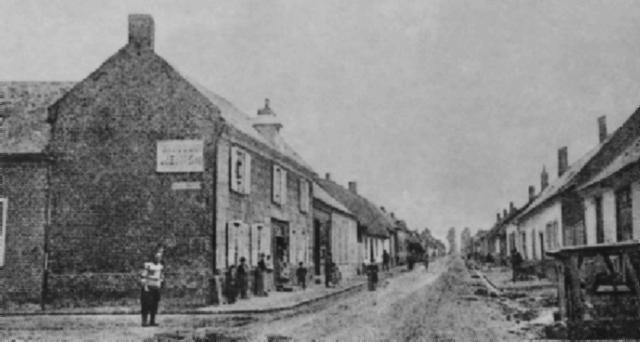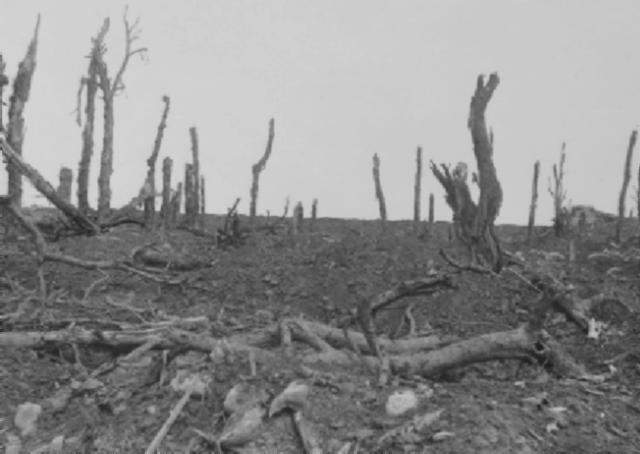Topic: BatzG - Lone Pine
The Battle of Lone Pine
Turkey, 6 - 9 August 1915
Bean Account Part 1

The following extract is from Bean, C.E.W., The Story of Anzac, Vol. II , 1924, pp. 497 - 534:
CHAPTER XVIII
THE ATTACK UPON LONE PINE
The front line of the Turkish trenches at Lone Pine could be seen from the Australian front on the same plateau, its high-heaped parapet showing clearly over the sparse low scrub' at a distance of from 60 to 100 yards. The surface of the plateau was almost level, and its northern half, where the grassy square of the Daisy Patch still lay between the lines, was completely bare of scrub. But the Turks, by extremely laborious digging, had established their line round the head of Owen's Gully, whence it wound 400 yards southwards through the scrub, skirting the Daisy Patch and crossing the plateau. From the southern edge of the Pine the same trench, dipping lower, continued along Snipers' Ridge.

The centre of the enemy's front on the Pine was far less advanced than its two flanks, receding towards the Turkish rear and merely serving to connect the advanced flanks. Although the growth of these trenches had been anxiously watched since the early days, only a rough notion of their plan could be obtained by observers from the ground. In June, how- ever, photographs were taken from the air. From these, although the staff was at that time inexperienced in interpreting them, a rude plan of the Turkish trenches had been compiled; it was rough both in scale and detail, did not show the heights, gullies, or other natural features, and did not, therefore, make clear which trenches were on higher or lower ground. Nor did it show what was clearly to be seen in the air-photograph - that the southern half of the trenches had been generally roofed over. It exhibited fairly well, however, the general run of the enemy's lines, showing that a support line ran close behind the front on left and right, but that in the centre there were only a number of communication trenches leading back over the plateau and most of them ending at a transverse trench about a third of the way towards its eastern edge. This last was selected by General Walker as a suitable limit for the centre of his advance. It would, however, only afford a front of 160 yards. It was estimated, indeed, that this and the two flanks taken together would not, when first captured, conveniently hold more than three infantry battalions. It was therefore arranged that three battalions - the 2nd, 3rd, and 4th - should make the assault, and one - the 1st - act as reserve. The 3rd was to seize most of the deep central objective; the 4th and end the northern and southern flanks respectively. Each was to reach specified points shown in the map, and many officers spent part of the time before the attack in carefully noting through periscopes the line which they and their respective troops must follow.
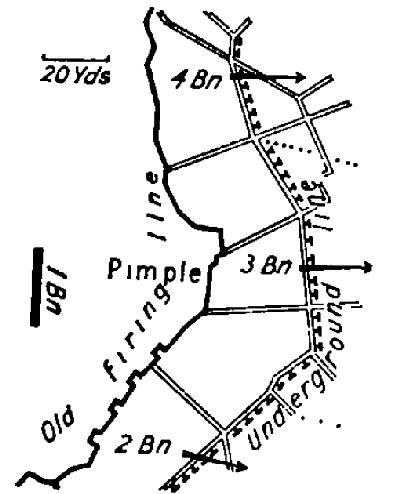
The general staff concentrated its efforts upon ensuring that the attacking brigade should be given a good start. This work mainly fell upon Colonel White of the divisional staff and Major King of the brigade. In order that the first blow should be an exceedingly heavy one, three lines - each a company strong - were to be launched by each battalion simultaneously, one behind the other; the foremost starting from the secret underground firing line in front of the Pimple, only forty to sixty yards from the Turks; the second from the old or main fire-trench of the Pimple thirty yards in rear; the third (carrying picks and shovels as well as rifles) was to follow from the main fire-trench immediately after the second. White and King had worked out on the spot, recess by recess, the space to be occupied by each battalion at its starting-point. The tunnels of the new underground line, as well as all important passages leading to the Pimple, had been widened, and each unit had been allotted a separate and clearly marked line of approach through these avenues.
In front of parts of their trenches the Turks had constructed a fairly strong wire entanglement. In order to destroy this, to break down head-cover - which was known to exist - and to damage the flanking positions or those against which later attacks were designed, there had been arranged a bombardment extending over three clays. This was not a destructive bombardment, as known later in France, since comparatively few shells were allotted for each day. But various "shoots" at a slow rate of fire were to occur on August 4th, 5th, and 6th, and were to be followed on the third and final day by an hour's' intensive bombardment by all guns. The nature of the slow bombardment may be illustrated by the shooting of the 1st New Zealand Field Battery on Russell's Top, which was the only field-battery commanding the Turkish wire entanglements at the Pine, and was therefore charged with destroying them. For this purpose it was to fire at fixed hours on August 3rd, 4th, 5th, and 6th, a total of 125 shells. The first day's "shoot," in which were used 24 high-explosive and 11 shrapnel shells, was intently watched from the infantry trenches. "Medium result," notes the 3rd Battalion diary. "Not much damage done," says that of the 2nd. Next day it became clear that, with so meagre an allowance, the entanglements would not be broken down. Accordingly on the morning of August 5th the battery was ordered to use shrapnel, set to burst on percussion against the ground, and to continue firing until the entanglements were destroyed. An observing-officer was stationed in the Pimple, with a direct telephone line to his guns. Most of the shooting was performed by one gun of the battery, but by 3 p.m. on August 6th, after 383 rounds in all had been fired, the entanglement (except a few "knife rests ") had been destroyed to the satisfaction of the infantry commanders. During the night of August 5th star-shells were fired in order to prevent the enemy from repairing the damage.
The actual trenches of the Pine, which were in a large measure covered, were bombarded by two New Zealand howitzers of the new 4.5-inch pattern, and by two old 5-inch weapons of the 69th (British) Brigade. The same New Zealand howitzers, with another battery of the 69th, were responsible for Johnston's Jolly. The 4th (City of Glasgow) Battery of the Lowland Howitzer Brigade fired upon German Officers'; two Australian field batteries - the 4th and 5th - and a further howitzer battery of the 39th Brigade were directed upon The Nek and Chessboard. Thus the Pine itself - trenches and entanglement - was in reality being bombarded by at most eight guns, while for the whole of the slow bombardment preparatory to this attack there were allotted only twenty-eight.
At 2 p.m. on August 6th, as the last engineers were withdrawn from the Pimple tunnels, three mines were exploded in No-Man's Land between the Pine and the Pimple, in order that the earth thrown up might increase the slender cover available. At 2.30 the battalions of the 1st Brigade began to file towards the Pimple. An hour later several warships were seen taking position off the coast, far to the south at Helles, while others were approaching Anzac. About 4 p.m. the offensive began at Helles;8 the plumes of earth thrown up by the big shells could be seen leaping out against the distant skyline. Near Anzac a few minutes later the cruiser Bacclrante, from her old station off Gaba Tepe, opened in answer to Turkish batteries which were firing at her. At 4.30 the intensive bombardment at Anzac began; the guns which had been engaged in the slow shooting commenced to fire at a regular, though not rapid, rate. Those land batteries which had not previously taken part in the bombardment now opened upon the Turkish batteries and other usual targets. Two field-pieces of the 5th Battery were run up on to the open crest behind the old trench-line, 200 yards from the Turkish position. One of these, under Lieutenant Gatliff; succeeded in firing sixty rounds directly at the parapets of the Pine; the other, endeavouring to fire similarly at the Jolly, was hit by a Turkish' projectile. The ships' artillery was shelling more distant targets, chiefly on Gun Ridge and the main summits of Sari Bair.
At the time when this bombardment began, the three respective battalions destined for the assault were still moving by their routes into the Pimple. Immediately behind that battalions destined for the assault were still moving by their salient was the wide shallow depression - really the head of Victoria Gully - known as "Brown's Dip," which ever since the days of the Landing had formed the approach and centre of communication for this part of the line. On its broad paths and ledges, long since worn white by traffic, the supplies required for the fight had been stored. Here Brigadier-General Smyth of the 1st Brigade had installed his headquarters, the old brigade headquarters at the head of White's Valley, a few hundred yards to the north, being now occupied by General Walker and part of the staff of the division. In the centre of the Dip, in a series of long wide pits, were the companies of the 1st Battalion, the reserve unit, which had been moved thither before the other battalions began their march to the starting-point. Past it through the Dip were now filing in three separate routes its three sister battalions - the 2nd, 3rd, and 4th - which were to make the attack. The bright sun of a warm summer afternoon shone upon their backs, white calico squares, and broad white armlets. Behind them, far down on the twinkling sea, lay the warships, firing occasional salvoes. The three columns steadily disappearing into the dusty rabbit-warren of trenches reminded onlookers of the regulated traffic of a metropolis. At one moment, fearing that the 2nd Battalion, by blocking certain trenches, might cause the deployment to be late, Major King came, flushed with haste, to a point of congestion. To save time, part of the 3rd was eventually moved through the old firing line instead of by its allotted route. When the bombardment was half-through, the three assaulting battalions were in position both in the tunnelled firing line and in the main line behind it, ready to launch the formidable demonstration upon which so much depended.

Until the last only one doubt obsessed the regimental officers-whether the men, sick with diarrhoea and strained with lack of sleep and heavy work, could sustain prolonged fighting or marching. But, as the battalions marched to the starting-point and settled themselves to wait for the signal, their officers - as often afterwards in France - watched with intense interest the evidence of qualities which, till the end of the war, never ceased to surprise even those who knew the Australian soldier best. Whatever their previous feelings, the actual filling and dumping of their packs, the march through the trenches, and the imminence of the advance after months of trench life, provided an excitement which put new vitality into the troops. As they waited in the crowded bays, there was not the least sign of nervousness in face, speech, or action. The prevailing thought was: "It's the turn of the 1st Brigade to show what it can do. The men chaffed each other dryly, after the manner of spectators waiting to see a football match. Some belated messenger hurried along the trench to find his platoon, and, in passing, recognised a friend. “Au revoir, Bill," he nodded, "meet you over there." - "So long, Tom," was the answer; "see you again in half-an-hour." In the opening of the main tunnel – B5, leading forward from the old firing line to the new underground line - stood Major King, whistle in one hand, watch in the other. At the corresponding opening in the underground line was Major McConaghy of the 3rd, ready to repeat the signal for the attack - three blasts of the whistle. Watches had been twice compared and corrected, and while the officers gave a few last hints to their men they kept an eye on the minute-hand as though they were starting a boat-race. “Five twenty-seven-get ready to go over the parapet," said a young officer" crouched in the corner of one fire-step, glancing at his wrist-watch. Almost immediately the order came: “Pull down the top bags in that recess." The men on the step dragged down the uppermost row of sandbags, thus rendering the exit easier. “Prepare to jump out," said the officer, putting his whistle between his teeth. The men of the second line on the fire-step crouched higher against the wall. Those of the third, on the floor of the trench, took a firmer foothold for their spring. A whistle sounded and was repeated shrilly along the front. In a scatter of falling bags and earth the young officer and his men scrambled from the bay. Rifle-shots rang out from the enemy's trenches, gradually growing into a heavy fusillade. One of the men leaving that particular bay fell back, shot through the mouth. From every section of the Pimple, and from the holes of the forward line, troops were similarly scrambling; the sunny square of the Daisy Patch and the scrub south of it were full of figures running forward. At the same time a tremendous rifle-fire from the Anzac line immediately north of the Pimple began to raise the dust in spurts from the parapets of the Jolly. This was the fire of the 2nd Infantry Brigade, endeavouring to suppress the Turks in the Jolly while the 1st was making its attack. The 3rd Infantry and 2nd Light Horse Brigades south of the Pine were meanwhile attempting by the same means to silence the enemy in that quarter also.
It appeared to onlookers that as soon as the attacking troops began to reach the enemy's trenches there occurred an unforeseen check. Instead of disappearing into the trench, they could be seen standing by its nearer edge, until there was strung along it a crowd not unlike that lining the rope round a cricket field. Fresh men were still running across often tripping in the scrub or the barbed-wire in front of the Pimple, a few lying still, the majority picking themselves up to run on again. As each joined the crowd at the enemy's trench, he would move to left or right in search of a place. On the right a number lay down along the enemy's parapet. Here and there stood one firing at some target beyond as coolly as if he were shooting in the paddocks at home. The crowd, which remained for fifteen minutes kneeling or lying along the enemy's parapet, made it difficult to observe what was happening on the farther side; but bayonets could occasionally be seen moving deep into the Turkish position. In the meantime it was evident that the Turks in the Jolly had begun to recover; for, although that grim warren of trenches was absolutely devoid of visible signs of life or movement except for the dust of Australian bullets spurting in clouds along its bare parapets, from some point in it two machine-guns were now sweeping No-Man's Land. Several Turkish batteries also had opened, and the shrapnel burst constantly - first over the front line at the Pimple, and presently over No-Man's Land - the view being sometimes entirely obscured by the clouds of yellow smoke and dust floating by under the rays of the setting sun. The position of any man outside the trenches was evidently becoming precarious, and the remnant of the crowd by the parapet began to jump into the Pine. Only on the right did a line of men still lie in the open. Not until an hour later did onlookers realise that they were dead.
What had happened was this. The men's previous know- ledge of the trenches to be attacked can be gathered from the sketch, reproduced opposite, which was drawn by Sergeant- Major Goldenstedt from the 3rd Battalion's lines opposite the Jolly. Upon crossing No-Man's Land they had found the enemy's barbed-wire entanglements thoroughly beaten down, but, instead of a trench, they were confronted by a continuous sandy mound forming the roof of a covered gallery. All knew that some head-cover would be met with, but none were prepared for this; and the attack at once split into two separate fights - one portion of the troops staying at the front line and gradually entering it, another part racing farther ahead to where the saps were open and establishing themselves there.
Those who stayed at the front trench found that the head-cover rested upon massive timbers, and below the eaves of these were numerous loop-holes, from some of which the puffs of rifle-blasts were spasmodically spurting. On the right was one particularly high mound of head-cover, which had been assumed to be a field-gun emplacement. Captain Pain and some of his men of the 2nd made straight towards it, when, half-way across, they perceived that it was a machine-gun emplacement with a clumsily-built log roof. They could see the tongue of flame from the gun and the crew fumbling about the weapon, which in the excitement was firing unduly depressed, the bullets tearing up the dust close in front and passing harmlessly. Elsewhere also many Australians, perceiving the puffs of rifles firing through loop-holes, picked their way so as to avoid them; others, not heeding the holes, were killed as they passed.
The line of heaped-up roof, resting on timbers of six by four inches and even of nine by four, was far too heavy to remove, and the bombardment had left it practically unbroken. There were a few holes, some made by shells, some sally-ports through which Turkish patrols had been wont to creep out
at night; here and there a few feet of trench had been left open between long covered shelters. Some of the Australians stood over these, shooting into the dark passages beyond, from which shots were returned. It was presently found that, in order to avoid the bombardment, nearly half of the enemy's garrison had been moved into the Turkish mine-tunnels which ran from this front trench in the direction of the Australian line. On the alarm, a few men had issued from this shelter, but the attack had come upon them too swiftly to allow of their manning the line, and the majority remained penned in the tunnels, fearing to move. Among the attacking Australians there were not wanting men of reckless gallantry who leapt almost immediately into the open spaces, or even let themselves down, feet foremost, through the holes in the head-cover. A number were killed both on the edge of the trench and inside it, but parts of the front line were thus occupied and the enemy in the tunnels completely cut off. Lieutenant McLeod of the 3rd then ordered into the front line such men as were still lining its parapet. Part of the central sector of the trench, which was but half-covered, became thus unduly crowded; but to move forward through the maze of communication trenches was at that stage most dangerous and difficult. The men were therefore led out again over the top by Lieutenant Woods and others towards those farther positions to which, as has been explained, other parties of the attacking force had from the first directed themselves. To these parties the narrative must now turn.
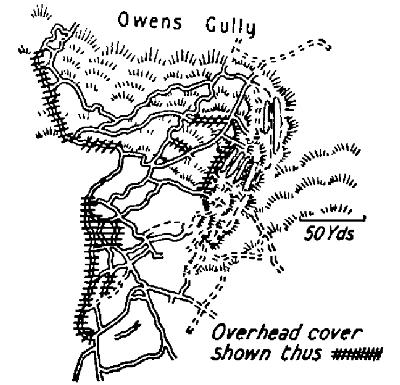
It was only the advanced portion of the Turkish positions that had been generally roofed over.
As has been already explained, the central loop of the front trench and the maze of communications running back over the plateau were almost devoid of head-cover. From the very first a number of officers and men, perceiving this, made no pause at the front line, but ran on beside the open saps in search of a suitable point of entrance. In some of the battalions the order had been given, in accordance with a theory then accepted in France, that the first line of troops should ignore the enemy's front, trench, leaving it to be dealt with by those who followed after, and should pass on to the farthest objective. Consequently some of the leading officers, followed by a number of the men, raced straight on over the enemy's head-cover in the direction in which they judged their final objective to be. Others, though no such instruction had been given in their case, barely paused at the covered line, but hurried on beside the maze of open communications. As they ran they caught sight of Turks bolting back through these avenues in twos and threes, and stood shooting down at them. It was far easier to fire at the enemy from above than from a. the trench itself, and some of the Australians continued to do so, until they became aware that few of their own side were now moving outside the trenches, and that the slopes were ominously bare; for numbers of daring men, including many officers, had leapt into the trenches as soon as they reached an empty space, and had begun to feel their way through them. Many were killed within a few minutes of entering, since it was easy for a single Turk, at bay beyond a bend and warned by a bayonet coming round it, to shoot one man after another. In several places Australians lay dead four or five deep, having been shot in this manner, sometimes with a heap of Turks similarly killed a few yards distant from them. The Australians quickly learned to hold their rifles vertically so as to give no warning of their approach, while the slower-minded Turk pointed his bayonet along the trench. Bombs would have subdued most of this opposition; but, though arrangements had been made to provide bombing squads, these were immediately disorganised, the supply of bombs was intermittent, and few men knew how to throw them. Moreover, it was often impossible to be certain whether those round the next corner in this labyrinth were friends or enemies. Thus a few men with Major Morshead were held up at a corner by some unseen party beyond it. One of them, believing that the opposing party was Australian, went forward to see. A moment later he returned. "They are Turks all right," he said quietly," and they got me in the stomach." After talking quietly for a few minutes he sat down and shortly after died in great pain. Similarly, when three men, who leapt in beside Captain Pain of the 2nd, pushed eagerly round a support trench on the right, three shots rang out, and they all fell dead. In the exact centre of the position Captain Lloyd of the 4th, whose men made farther to the left, rushed ahead by himself, and reached a point where a howitzer-shell had broken down the side of the open trench, rendering access to it easy. He looked down on a number of Turks, who scattered round the bend on either side as he jumped in. As they attempted to return, he watched first one side and then the other and shot several. Presently, realising that he had fired the last cartridge in his magazine, he dropped and feigned death. Turks brushed against him, passed over him, handled his rifle, but did not tread upon him. It was twenty minutes before he was turned over by a man of the 3rd Battalion and knew that the trench was in Australian hands.
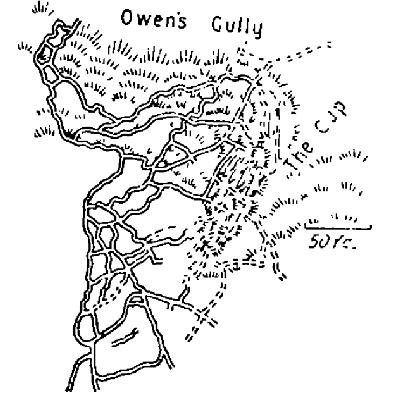
Working thus through the trenches, or running over the top, certain leading officers and men had begun, within a few minutes of the start, to reach rhe neighbourhood of their objectives. Those in the centre quite unexpectedly found themselves approaching a steep gully, which bit deeply into the Lone Pine plateau across almost the whole front of the attack. This was the depression – a deep inlet branching at right angles off Owen's Gully - which, in the narrative of the Landing, has been named “The Cup," and the existence of which was barely suggested in any maps possessed by the attacking force. It completely limited the advance to the east, part of the chosen objective lying, as a matter of fact, in an unattainable position down its But above its edge, round the area bordered by Owen's Gully on the north, The Cup on the east, and the slope to Snipers' Ridge 011 the south-that is to say, round nearly the whole of the Lone Pine works-the Australians had before dark hurriedly established a line of defensive posts which must now be described in some detail.

On the extreme left of the attack, where the Turkish front line, covered with heavy timber, rounded the head of Owen's Gully, part of the 4th Battalion under Lieutenant Giles, having crossed the front trench, jumped into the support trench eight or ten yards beyond, at a point where shells had partly wrecked it.
It being part of the duty of the 4th to barricade the northern end of these trenches, Giles made to the left, but at a bend of the trench every man who attempted to advance was instantly shot. After three or four, including Giles, had been killed, two trained bomb-throwers arrived, and endeavoured to suppress the opposition by flinging grenades round the corner. At this juncture Captain Milson, one of the most gallant and admired leaders in the battalion, came up. Believing that the unseen enemy at this point might be overborne, he called on the men to follow him and led the way round the corner. He was immediately shot dead, falling across the body of Giles, but his men continued to roll bombs round the bend, and presently the enemy surrendered. It was then discovered that beyond the turn there was a covered trench or tunnel leading towards the front line. In this had been penned a Turkish officer and thirty men, who had been shooting everyone who passed its mouth.
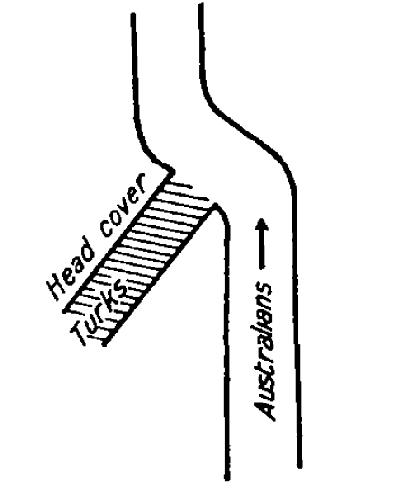
As the Turks in the tunnel surrendered, there came along the trench Lieutenant Seldon of the 4th. One of his eyes had been shot away, the wreck of it hanging shattered on his cheek-bone. He would not hear of having his hurt tended, but, seeing the urgency of blocking the northern end of the trench, he ordered Lance- Corporal Aylward and others, including a bomb-thrower, Private Hayward, to move round the front line while he led a party along the support trench. Going first himself, he reached a point where the support and front line, becoming again connected, descended sharply to the bed of Owen's Gully. Here a Turk from the Jolly shot him dead; but Corporals Aylward and Stone, by means of bombing, kept the enemy at a distance below while their united parties constructed a barricade near the point where Seldon had been killed. Behind this block Aylward, with several bomb- throwers, took up his position. The extreme left flank was thus secured in exact accordance with the plan. The support line south of this post was turned into a fire-trench, facing down Owen's Gully.

Fifty yards south of Aylward's block a communication sap ran eastward along the side of Owen's Gully, with a second trench winding parallel to it, but higher, along the edge of the slope. The moment the attack started, Major Iven Mackay of the 4th at the head of a number of men dashed across No-Man's Land, and, without halting at the front Turkish trench, raced over the surface beside the upper of these two saps - a comparatively narrow avenue - toward what they knew to be their objective. As they ran, firing from the hip, they killed several Turks who were fleeing along the trenches below, but one of the enemy turned and shot Sergeant Griffiths, another mortally wounded Lieutenant Merivale. Perceiving another communication trench with broad buttress-like traverses, a wide open sap which came obliquely from the right and crossed the first at right angles, Mackay veered towards it and, jumping in, pushed on till he approached the point where the two crossed. Here he stood, shooting a number of Turks as they dashed down the narrow trench and past the cross-ways. Presently, when no more came, he judged that the trenches farther back were now in Australian hands, and, running on to the junction, leapt across it. But a young corporal - a Duntroon boy named Mills - who attempted to follow, was killed as he crossed the junction by some Turk shooting from farther along the narrower trench. The next man following Mills, and attempting to cross as he had done, was shot dead by the same Turk. A third suffered the same fate. The remainder of the party paused on their side of the junction.

Mackay was thus alone beyond the junction in a section of the broad communication sap, which for clearness will be called the "Traversed Trench." It here formed a spacious well-constructed bay, as wide as a small room and about ten yards long, running down the slope of Owen's Gully. The sides had been neatly revetted, evidently by engineers, and on that nearest to the Australian line was a fire-step. On this Mackay took up his position. He had scarcely done so when into the lower end of the bay came three of the enemy. Mackay attempted to fire his rifle, but the trigger merely clicked, the magazine being empty. Lunging with his bayonet, he grazed the leader of the Turks, who all three turned and ran.
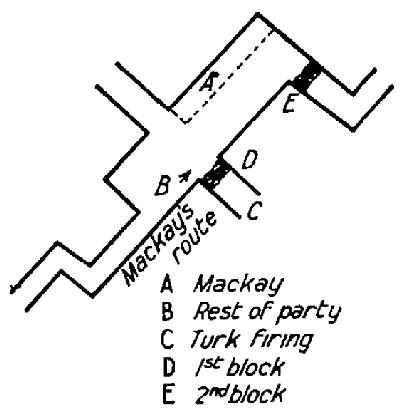
Mackay now instructed the survivors of his party, who were behind him on the mouth of the narrower sap, up which the Turk who had shot Mills was still firing. He himself kept guard in front of the men as they built. As he did so another Turk appeared round the same corner as before. Mackay, warned by the man's bayonet coming round the corner, easily shot him. The barricade was soon raised sufficiently high to enable one of the men to lie behind it, push his rifle between the bags, and fire at intervals down the narrower sap. It then became possible for the rest of the party to cross the opening and join Mackay. Still keeping guard, he set them to block the Traversed Trench also at the lower end of his bay. Before dark both trenches had been barred. The barricades were hilt higher, so that two rifles could be fired through each. Fire-steps were cut on the side of the bay nearest to the enemy, and both its sides and its dead-end were then manned. The post thus established overlooking Owen's Gully was strongly held: facing west, north, and east, it formed the north-eastern angle of the new Australian position in Lone Pine. Of the parallel sap lower down the gully only a third was occupied by the Australians, the barricade in it being held by a party under Lieutenant McDonald, the quarter- master of the 4th.
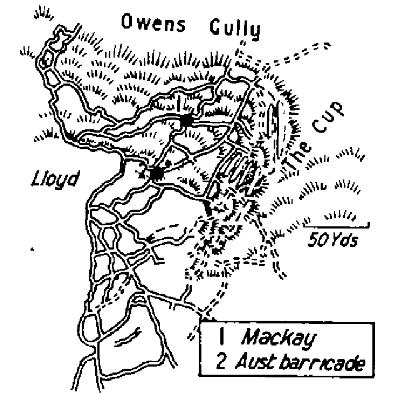
While the northern flank of the 1st Brigade's foothold was thus secured by Mackay's Post at the northern end of the Traversed Trench, the southern end of that trench had also been entered by Australians near the centre of the old Turkish front. Captain Lloyd, who had been forced to feign death until rescued by men of the 3rd Battalion, had pushed eastward along a communication trench which may be called "Lloyd's Trench." At twenty yards from the old Turkish front line there branched from it diagonally to the left (or north-east) the Traversed Trench. Passing this by, Lloyd found that his trench soon veered north-eastward also, leading in front of and almost parallel to the Traversed Trench, straight down the slope towards the Jolly. As the Turks on the Jolly could here see him from head to feet, Lloyd withdrew round the corner and blocked his trench at a point slightly in advance of its junction with the Traversed Trench. The latter was occupied by a garrison under Lieutenant Osborne of the 4th, and, extending from Mackay to Lloyd, formed a sort of front line covering the northern half of the captured position. South of this there ran across the new Australian position another diagonal sap-really a south-westerly continuation of that from which Lloyd had had to withdraw. This long north-easterly avenue, afterwards known as "Sasse's Sap," formed eventually the centre line of the Australian position in the Pine. In the first rush a number of the 3rd Battalion, led over the Turkish front by Captain Moore and Lieutenant Garnham, found themselves looking down into it while a number of the enemy scurried past to the rear. After many of these had been shot, Moore ordered his men into the trench. In leaping in himself, he fell on the bayonet of a dying Turk, and was wounded. Captain Dawson, an officer newly arrived from Egypt, who came up a few minutes later, was shot dead. About that time, however, there arrived Lieutenant D.R. Brown with one of the machine-gun crews of the 4th Battalion. Although the other battalions had left their respective machine-gun sections to follow as a last reserve, the commander of the 4th had allotted a special duty to each of his guns and had ordered them to go forward with the first assault. At this stage of the war the machine-guns of the infantry were being increased from two to four for each battalion. Four guns therefore accompanied the third line of the 4th Battalion. Of these three were lost in No-Man's Land, but Brown, crossing the enemy's front line with the fourth, set up his weapon on the surface immediately behind Sasse's Sap.

This trench, as has been explained, led directly towards the Jolly, and the machine-gun crew, looking in that direction for its pre-arranged target, found it at once in plain view - a communication trench packed with Turks and only 160 yards distant. Brown ordered a few of the 3rd to climb out of the trench and lie in the open as a guard for the gun. The machine-gunner, Private Edwards, then poured his fire into the thick of the crowded enemy.
The sound of one of their own machine-guns opening so early from the new front line greatly encouraged those of the 1st Brigade who were near it, while it produced a strong effect upon the enemy. It became at once the centre of a storm of Turkish fire, and a machine-gun from the Jolly killed the men of the 3rd who were guarding the Australian gun. Sergeant McMahon and all the crew were hit. In spite of this opposition the machine-gun had expended 700 rounds before an enemy field-piece on the Ridge burst its shrapnel over the spot, tearing the ammunition belts and rendering further action impossible. Brown took down the gun and began to repair it. Private Railton Macdonald, who then took charge of the post, was shortly afterwards wounded - for the third time in twenty minutes - by Turks who were now established in some cross-trench a few yards distant. Major Austin, who came round the position, was presently killed. Nevertheless Sasse's Sap was gradually fire-stepped, barricaded, and firmly occupied.
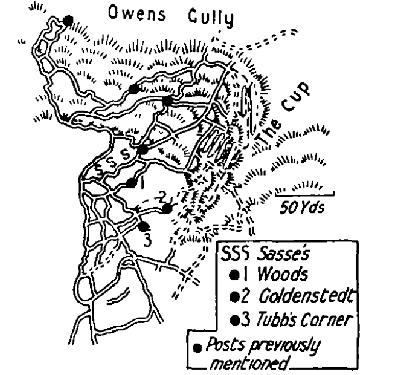
Forty yards farther along the south-easterly trench from which Sasse's sprang there opened a shorter avenue, parallel with Sasse's -not so much a trench as a track running on to the surface of the Pine. It was at first overlooked in the consolidation, and Major McConaghy and Sergeant- Major Goldenstedt, going round the position before dark, unwittingly walked out through it on to the open plateau, where they found themselves standing not far from a broken tree-stump, which both instantly recognised as that of the famous pine. Shots from the Jolly and a shell from Gun Ridge whizzed past them as they turned and dived back into the trenches. This trench, or track, and a parallel trench between it and Sasse's Sap were presently barred by Lieutenant Woods and by some of the men whom he and others had led forward to relieve the congestion in the old Turkish front line. Woods barricaded the trench next to Sasse's, and by transferring its parapet to the eastern side formed an isolated post like that in Sasse's, fronting towards The Cup.
The communication sap from which these two trenches and the track opened ran south-eastwards until it approached the head of The Cup. Here, just beyond the track, a short branch-sap led to that depression: and immediately afterwards the sap itself, turning sharply to the left, formed a second connection with The Cup. At this bend, which will be called in this narrative "Tubb's Corner," Lieutenant S. A. Pinkstone, Corporal Haua, and some men of the 3rd endeavoured to establish a post. The sap had been either broken down by shell-fire or blocked by the enemy; and in the corner so formed Pinkstone and Haua made recesses as best they could with entrenching tools. The importance of Tubb's Corner was so obvious that fragments of all battalions were hurried along to it. Pinkstone and Haua were soon wounded, the latter mortally, but the post was maintained. The avenue north of it was also occupied. This short sap, in which several Turks, including a white-bearded officer, had been killed, was probably an outlet for mine-spoil, since it ended in a “chute" of earth. It was occupied by Sergeant-Major Goldenstedt, with Corporal McGrath and about twenty-five men. This post and that at Tubb's Corner formed the right flank of the 3rd Battalion. On the south the 2nd Battalion had attacked with its right on the southern edge of the plateau overlooking the gullies and spurs leading towards Gaba Tepe. Here the Turkish front trench was more completely covered than elsewhere, with the result that the check at the front line lasted longer. Nevertheless some of the battalion, at once crossing the head-cover, found to their right, along the edge of the plateau, a wide and deep communication trench. Parallel with it, and at one point only five yards north, was a shallow sap, either unfinished or abandoned. The front line, from which both of these sprang, continued southwards down the abrupt slope to Snipers' Ridge, while the deep sap, with its shallow companion, trended north-eastwards and then branched, to end through several avenues at the head of The Cup.
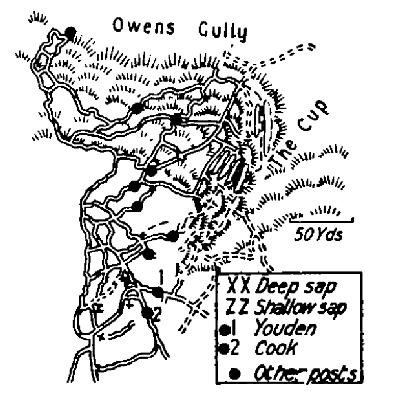
The deep sap, though inaccurately shown on the map, was recognised by almost all parties of the 2nd as their objective - the right flank of the intended Australian position in the Pine. Among the first eager leaders to reach it was a reinforcement officer who had arrived only the night before from Egypt but had begged leave to join the attack - Lieutenant Everard Digges La Touche, a missioner of the Church of England in Sydney. At its first bend he and two of his men fell mortally wounded, and a few Turks remained at bay in this corner for half-an-hour after Australians had passed it, until they were driven out by some of the 1st Battalion. Meanwhile Major Morshead, Lieutenant Youden, and others pushed down its south-easterly branches, shooting at some of the enemy, who fled to their brushwood-covered bivouacs in The Cup or into the old gun-pits into which the Australians had penetrated at the Landing. Near the head of The Cup, Youden found his party held up by enemy farther along the trench. This position, which was nearest to the gully-head, was forthwith barricaded with sandbags, the neighbouring branches of the trench being similarly stopped by men of the 2nd under Captain Cook and Lieutenant Harkness. The less advanced outlets from the sap were similarly stopped, and a definite right flank was thus early established by the 2nd in the Pine. Its most advanced posts, under Cook, Youden, and Harkness, were not directly connected with the 3rd Battalion farther north. But Tubb's Corner was only twenty yards away, at the end of the unfinished or abandoned trench before mentioned, and all three battalions at an early stage found touch with each other through the rear trenches.
Thus by 6 o'clock the three attacking battalions of the 1st Brigade had established themselves in the Pine, holding a long communication trench on either flank, and in the centre seven or eight isolated posts in as many communication trenches. These posts, surrounding the captured position as the finger- knuckles surround an outspread hand, constituted a formidable defence. In the meantime the enemy's organisation, which for a few minutes had almost disappeared, began again to make itself felt. Parties of Turks were now firing from behind the farther traverses or bends - taking their stand, to use the previous simile, at the finger-nails of the position - while an increasing fusillade was poured in from the Jolly. Signs of a coming counter-attack were already evident. Those Australians who could see down Owen's Gully or Legge Valley had early caught sight of Turkish reinforcements coming in continuous single file along the gully-beds, while on the side of the Jolly appeared an excited senior officer, who, with several others, surveyed the Pine through field-glasses and despatched messengers one after another down the gully. Reinforcements were therefore called for by Major McConaghy, then in charge of the 3rd Battalion in the Pine. An attempt was first made to signal this request by "Morse-periscope," an apparatus with which the attacking battalions had been provided, and which was not unlike a miniature window-blind at the end of a stick. The word "reinforcements" was deciphered, but the dust and smoke of the enemy's shells smothered the rest. A quarter of an hour later the signaller himself dashed over No-Man's Land with the message. In the meantime two others had run across the open with a telephone line, over which further messages began immediately to be received. Colonel Macnaghten of the 4th, who was himself in the Pine, reported that his men had penetrated 200 to 300 yards from the front trench, but that his left was weak, the Turks were massing to attack it, and reinforcements were required. This was followed by a further message from McConaghy: "Left safe. Centre wants a few men." At 6.19 it was reported that numbers of the enemy with fixed bayonets could be seen in the communication trench which crossed Owen's Gully from the Jolly From the Pimple itself the bayonets were visible, and General Smyth of the 1st Brigade, standing by the entrance of E5 tunnel in the old salient, and quietly sifting these and other messages, now sent forward part of his reserve battalion - the 1st. The tunnels which were to be used as communication trenches were as yet hardly passable; at various times excited soldiers - whom no one heeded - would rush up to Smyth ejaculating: Men smothering in that tunnel!" This was an exaggeration, since presently a slow stream of wounded began to debouch from B5, crawling, limping, but for the most part confident and well satisfied. But to move forward the reserves through the tunnel was impracticable, and therefore Captain Jacob with part of the leading company of the 1st went over the open into the right of the Pine. Here Colonel Scobie of the 2nd at once placed most of this reinforcement in the right-flank sap. Overhearing him express disappointment that no bombs or machine-guns had been brought, a private named Judd asked for written authority to get the gun, and then ran back alone over No-Man's Land, returning presently over the top with that weapon. Meanwhile Captain Sasse, with another portion of the 1st, had gone forward to help the 3rd to connect its front with the 2nd. The two remaining companies of the 1st were trickled slowly through B5 sap to reinforce the already somewhat congested trenches in the northern half of the Pine. By 8.30 the whole reserve battalion, including its newly-arrived reinforcements organised in a special party, had been sent into the Pine. The 12th, the next reserve, had been summoned to stand ready in the Pimple.
Thus before sundown, by dint of heavy fighting, the position had been taken and had been reinforced against the imminent counter-attack which the Lone Pine assault had been designed to evoke. Within two hours of nightfall the N.Z. & A. Division must launch the main offensive north of Anzac. If by then the enemy had committed his chief local reserves to a counter-attack at the Pine, the N.Z. & A. Division, advancing through the night towards Chunuk Bair, might find its crest weakly defended or even vacant. The whole effectiveness of the Lone Pine feint therefore hung on whatever counter-measures Essad Pasha might take.
It has been explained that the Turkish commanders had several weeks' warning of an impending offensive. Some reports had even purported to indicate the probable point of attack, but none were regarded by Liman von Sanders as trustworthy, and he was thus forced, as before the Landing, to judge this matter for himself. “Hardly any indication," he writes, "could be gathered." It was, however, a consideration that, while at Helles no open flank existed, at Anzac both the British flanks were open. “On their southern flank at Anzac," he says, “the enemy had on several occasions endeavoured to gain ground. The result had been merely a trifling bending back of the left flank of the Turks. On the northern flank of the English a smaller detachment - little more than a battalion - had been thrust out to the north, somewhat isolated from that flank. This fact appeared to me to be not without significance, but Essad Pasha did not think that any menace was to be inferred from it. Several attempts to dislodge this English detachment - for which purpose there were actually detailed some of the headquarters-troops of the 5th Army - came up against a tough resistance and were unable to fulfil their object.
"These were the sole indications which perhaps might have pointed to an intention to extend the front in that locality. But the evidence was very insignificant. There still existed the possibility that, by an operation directed against the narrow neck at the upper end of the Gulf of Saros, the Peninsula might be completely cut off from communication with Constantinople. A renewed landing on the Asiatic side was, after the previous miscarriage, improbable.
“The main anxiety of the 5th Army lay in the open area between the Anzac and Helles fronts, since by a strong landing in this area the rear of the Turkish army at Helles would also have been threatened. The relief of a portion of the troops previously engaged on the Helles front, and the accession of other reinforcements, had made certain units available. Consequently the 9th Division under Colonel Kannengiesser was moved into the open area referred to on the western slopes of Kayali Tepe (a western prominence of the Kilid Bahr Plateau)."
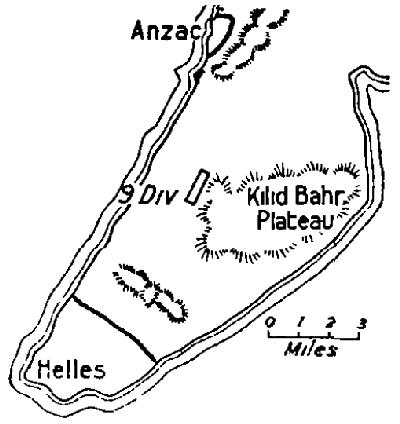
The apprehension of the enemy had, therefore, before the battle been turned in precisely the direction towards which Birdwood and Skeen had endeavoured to attract it. The demonstrations of June and July had apparently been interpreted as "endeavours to gain ground" to the south of Anzac; the quiet tactics pursued on the northern flank had diverted Essad's fears from that quarter. The activities of Turkish spies, whether in Egypt or in the islands, had not given them the faintest indication as to the direction in which the blows would fall.
On July 26th, when von Sanders was in the midst of his preparations against the then imminent offensive, he was astonished by receiving a sudden summons to visit the German G.H.Q. on the Western Front. This order, the result of an intrigue initiated in Turkey, he successfully combated; but not till July 30th was he assured that he might remain in Gallipoli and carry out his preparations for the impending offensive. To meet this his forces - which had been accurately estimated by Hamilton's staff - were at the beginning of August disposed in the following manner.
The Helles "group," commanded by Vehib Pasha, a brother of Essad, consisted of the 1st, 4th, 8th, 10th, 11th, 13th, and 14th Turkish Divisions, opposing which were four British and two French divisions. Covering the coast between Helles and Anzac was the 9th Turkish Division, commanded by a German, Colonel Kannengiesser. North of this, under the command of Essad Pasha, the Anzac "group" - opposed to the 1st Australian and N.Z. & A. Divisions - comprised the 19th and 16th Divisions holding the trenches opposite the main Anzac line, and one regiment of the 5th Division - the 14th - stationed in the hills north and east of the New Zealand out-posts. The 5th Division had suffered heavily on May 19th at Anzac and in mid-July at Helles, and had returned to rest at Anzac. It was thus that its 14th Regiment had been bivouacked in the quiet hill-sector, while the 13th and 15th were retained by Essad as his reserve - the 13th in the valley south of Kojadere, about a mile south-east from Scrubby Knoll, and the 15th in Kurt Dere, among the steep gullies three-quarters of a mile inland from Chunuk Bair. In closer reserve was a resting battalion of the 72nd (Arab) Regiment, of the 19th Division, in bivouac behind Mortar Ridge. The "Northern Group" was at this time probably 21,000 strong."

Beyond the Northern Group there was stationed, observing the coast at Suvla and Ejelmer Bays, and patrolling the neighbouring district, a small scattered force under Major Willmer, a Bavarian. This included in all only four battalions (mainly of gendarmes), a squadron of cavalry, and eleven guns. Much farther north, distant two days by road, there were maintained near Gallipoli the 7th and 12th Turkish Divisions, assuring the defence of the Bulair Lines. South of the straits were forces amounting perhaps to a division. As the nearest available railway station to the Peninsula was Uzun Keupru, on the Adrianople line, ninety miles from Anzac, and as the British submarines were making precarious the sea- transport of Turkish troops, the forces thus enumerated were the only ones likely to affect the fate of Hamilton's offensive.
It will be evident to the reader that the attack of the 1st Australian Division at Lone Pine would not be successful unless it induced Essad Pasha to throw in against it the 13th and, if possible, the 15th Regiments, both of which were lying in reserve only a few miles from the summits which the N.Z. 8z A. Division hoped to attain at dawn."
Although Essad Pasha had received no information of the landing of the New Army troops at Anzac, certain movements of the ships had rendered him suspicious. He had warned his force that either a relief or a reinforcement was in progress at Anzac, and, in the hope of obtaining definite evidence, he offered f g for the capture of a prisoner. In spite of this foreknowledge, and of the warning received from Europe that the offensive would probably commence early in August, the slow bombardment upon August 4th, 5th, and 6th, with which it actually began, was so moderated that it was not recognised by the Turks as the prelude to the outbreak. It chanced that on the 5th the commanders of the Turkish garrisons at Johnston's Jolly and German Officers' - Abd el Rizak Bey and Zeki Bey - were ordered to exhibit from their front trenches placards displaying the news that Warsaw had been captured. These notices ("Warcheuve est tombe" (sic), "La chute de Varchord," and “Varsaw ash fallin") had no more important influence upon the Anzac morale than to cause one sentry to remark grimly: "Well, let's see if we can't make his - notice fall too," upon which he set himself to shoot down the poles supporting it. But some of the Turks obtained the impression that the bombardment by howitzers which presently fell upon their trenches came in retaliation for the setting up of the placards.
Yet, slow though it was, this shelling caused heavy loss, especially in the crowded trenches of Lone Pine. The adoption everywhere of thick head-cover, which had given almost complete protection against Japanese bombs, proved disastrous under howitzer bombardment. The roof detonated the shells, which pierced it, burst in the covered trenches, and caused terrible losses. On the morning of August 6th, of some twenty odd shells which fell on German Officers' Ridge, five burst in the trenches, killing or wounding twenty-two men. In Lone Pine the losses were heavier. On its southern slope, where it dipped to Snipers' Ridge, the front trench was almost completely destroyed. It was the slaughter caused by a few shells bursting in the trenches on August 5th which caused the front-line garrison to be sent forward into the mine-tunnels when the howitzers opened on the 6th.
Even when that final bombardment was laid upon them, the troops in the Pine expected no attack. Similar shelling seemed to have occurred before. Suddenly one of the officers or NCOs who were keeping watch in the front line shouted: "Look out. The English are coming!" A sergeant rushed to the tunnels to get his men out, but it was too late. Before the garrison emerged the Australians had reached the trench.
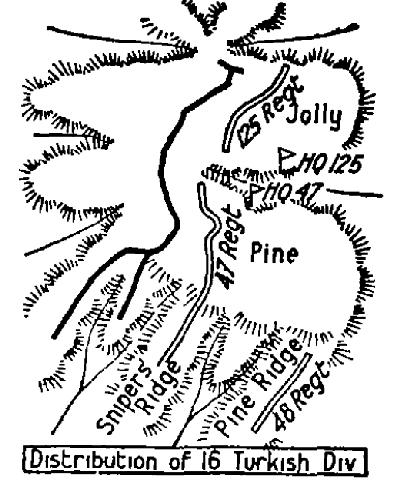
The Turkish garrison of Lone Pine consisted of two battalions of the 47th Regiment, of which a third battalion occupied Snipers' Ridge. The 47th was the central regiment of the 16th Division, of which the 125th held Johnston's Jolly, and the 48th Pine Ridge and the posts on Holly Ridge. The headquarters of the 47th and of the two Lone Pine battalions were in The Cup, where, unknown to the Anzac staff, the whole administration of the position centred. At least 500 men appear to have held the front trenches, with another 500 in close support. By 5.30, when the attack commenced, about half of the front-line garrison had been killed or wounded; most of the remainder was in the tunnels. When the attack cut off the majority, a few remnants of the supports came running out of the communication trenches into The Cup and thence down Owen's Gully. Some escaped across the gully to Johnston's Jolly, to a point near the slope of which the commander of the 47th Tewfik Bey, himself withdrew. One of the two battalion commanders, a namesake of Mustafa Kemal, believing - as was indeed true - that he had lost practically all his troops, retired to the lower end of Owen's Gully, and there awaited the arrival of any survivors. His colleague, a cool-headed leader, took up his position in some horse-stalls in Owen's Gully opposite the mouth of The Cup. Part of one company of the 47th had scrambled out of the north-flank trench and, after retiring some way down Owen's Gully (which was now almost everywhere under fire), lay in the valley-bed waiting for orders. In the trenches at the extreme head of The Cup appeared Australian soldiers. An officer and two or three men actually reached the headquarters of one of the battalions, which, as at Quinn's or Courtney's, lay at the head of the numerous tracks and shelves on the valley-side immediately behind the edge of the depression. These men were killed by shots either from the Jolly or from a few small parties of the enemy which still lurked among the shelters in The Cup or round the mouths of the communication trenches. As the attack reached its limits, these enemy parties, mostly under junior officers, stood fast, although every moment expecting to be swept away by another onrush of attacking infantry.
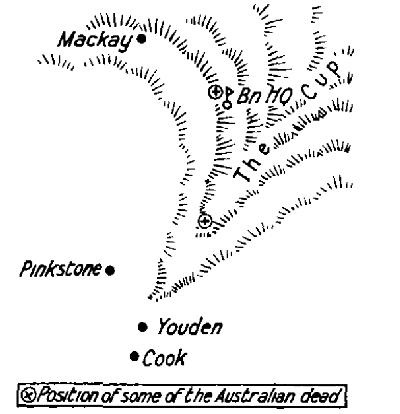
As has been already stated, Essad Pasha's "zone headquarters" on Scrubby Knoll overlooked at a mile's distance both Johnston's Jolly and Lone Pine, and an observer was kept stationed a few yards from the general's office, to give notice of any unusual occurrence. When, therefore, the attack opened it did not require a message from Lone Pine to inform Essad of its outbreak. In accordance with standing orders the batteries at Scrubby Knoll immediately opened upon the No-Man's Land in front of the Pine, and word instantly despatched to the 19th Division to throw in its nearest reserve - the battalion in rest behind Mortar Ridge.
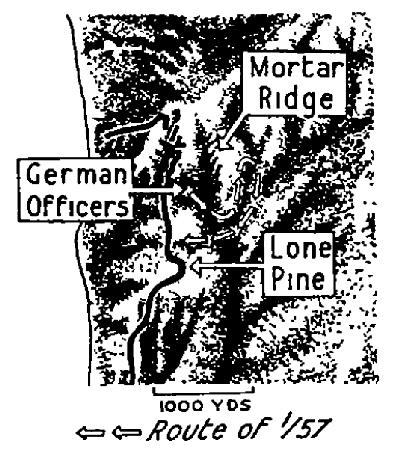
It happened that during the day the resting battalion had been changed. The 1st Battalion of the 57th Turkish Regiment, which had held German Officers' for forty-five consecutive days, was so completely worn out that, upon the urgent representations of its commander, it had been relieved by a reserve battalion of the 72nd and brought out to rest. While it was settling into its rest-bivouacs, the battalion commander with his chief, the colonel of the regiment, climbed to a ledge above regimental headquarters in order to ascertain the meaning of the increased outburst of artillery fire. Looking southwards they saw Lone Pine covered with the smoke and dust of shells, and at that moment the heavy reports of the guns gave place to a patter of rifles ("as, after thunder, you hear the rain begin," said one of them later). The regimental observer remarked that he could see men running across No-Man's Land. The commander of the 1/57th realised instantly that his men's hard-earned rest had vanished, since they formed the sole immediate reserve. He forthwith ordered them to put on again the equipment they had just dropped. A few minutes later there arrived the order, telephoned from Mustafa Kemal, for the 1/57th to move to the Pine. The battalion was then ready, and Zeki Bey ordered it to move at the double down Legge Valley, fixing bayonets as it went, while he himself, having told the leading company commander to meet him in Owen's Gully, ran ahead and turned into that valley.
He found the commander of the 47th, Tewfik Bey, on the side of Johnston's Jolly, but in a condition so disturbed that no useful information could be obtained from him. As, however, the position where he stood offered an excellent view over the rear of Lone Pine, Zeki Bey saw for himself that the centre of action was The Cup, and he accordingly hurried thither across Owen's Gully. His battalion had now got ahead of him, and, toiling after it to the topmost ledge of The Cup, where the communication saps from Lone Pine debouched, he found that most of his men had already been moved into those trenches. What had happened was that, as the battalion reached the top of the depression, young officers of the 47th, who were endeavouring to hold the ends of the saps, seized on various portions of the arriving 1/57th to reinforce their respective positions. None had been taken into the extreme northern sap, which was held by some of the 47th, but elements had entered each of the other communication trenches and were also congregated at the head of the valley.

Map Bean p. 528
The position in detail was as follows. The extreme northern sap - that blocked on the Australian side by Lieutenant McDonald-was still, along a good part of its length, in the hands of a remnant of the original garrison. The nest sap to it, one of the two blocked by Mackay, was held at about thirty-five yards from The Cup by a party of the 1/57th under its Hoja Mufti, or chaplain. This priest, a brave cool-headed man, was occupying an old somewhat broken-down bay in which lay several dead. The Australians were round the next traverse, and bombing was going on. "Don't be anxious about this flank - I will remain here," cried the Hoja to his battalion commander as the latter hurriedly reconnoitred the front.
South of this point, where the Australians approached more nearly to the edge of The Cup, the situation appeared to Zeki Bey more dangerous. The next sap but one was almost entirely held by the Anzac troops, whose bayonets could be seen beyond a traverse not far from the edge of the gully. Both sides were throwing bombs, and Zeki Bey could see that the spirit of his supporting troops was shaken by their having to pass over wounded and dying men in order to reach the scene of the fighting. Still farther south the head of The Cup, where there appeared to be a number of disconnected rifle-pits and much thrown-up earth but no definite trenches, was crowded with Turkish infantry. An officer of the 47th reported that the trenches in that quarter were in the hands of the enemy, and the men would not re-enter them. "The English reached even here," he said, pointing to an Australian lying dead beside his feet.
The Turks were thus holding the rearmost fragment of their old position at Lone Pine, but their situation was obviously critical. Only a few trenches, and those on the very edge of The Cup, were in their hands, and if the Australians again attacked these would certainly be lost. Accordingly, neglecting for the moment the position at the head of the valley, Zeki Bey went back along its western side, and, making his way through the saps, ascertained that one cross-trench, a few yards in from the edge, still remained in the possession of the Turks. This was a deep alley joining the ends of the communication saps, and without fire-step. He at once ordered the men in this area to leave all other work and, by digging fire-steps with bayonets, entrenching tools, or any available implement, to convert the sap into a fire-trench facing the Australian front. A non-commissioned officer was then directed to keep his men firing-"even if they could not see the English”, - so as to make a barrage. An irregular front was thus formed by the 1/57th and remnants of the 47th in the communication trenches and across the head of The Cup. Mustafa Kemal of the 47th, and his fellow battalion commander, came back to their respective headquarters on the edge of The Cup. The Australian advance had apparently ceased, and, since the whole immediate Turkish reserve had been absorbed, nothing more was to be done on the spot. Zeki Bey therefore went across Owen's Gully to the headquarters of the 125th on the Jolly to request Abd el Rizak Bey to turn the fire of his regiment upon the Pine.
It appeared somewhat strange that no attempt had been made by the 125th to counter-attack the Pine from the Jolly. It had, however, been reported to Abd el Rizak that the Australians in the line facing the Jolly appeared to be active, and that sandbags had been removed from the opposing trenches, as if to enable infantry to charge from them. As a matter of fact the 7th Australian Battalion had made such preparations, having been warned by Birdwood himself that, if the assaulting battalions were successful at Lone Pine, it might be required at dawn to attack Johnston's Jolly. Moreover a torrent of Australian rifle-fire was being poured upon the Jolly. Zeki Bey, however, implored Abd el Rizak to realise that matters were more critical at the Pine and to turn his fire upon it in order to demoralise the assailants. The commander of the 1/57th then returned to the Pine. Night was falling, and with it there arrived in Owen's Gully Ali Riza Bey, the commander of the 13th Regiment.
It will be remembered that the 13th was one of the two Turkish regiments which the whole Battle of Lone Pine was designed to attract. Completely deceived, Essad had at the very outset ordered it at all costs to retake the position. The feint had indeed so far succeeded almost beyond anticipation. Expecting. as he had done, that the British reinforcements would be thrown in towards Kilid Bahr, Essad at once assumed that the Lone Pine attack was the main intended offensive, and so deeply was he disturbed that he not only ordered the 13th Regiment to move immediately to the Pine, but instructed the 9th Turkish Division, stationed between Helles and Anzac, to move in that direction also.
It is not known whether any orders were sent to the 15th Regiment at this stage. What is certain is that the Turkish commander in the Anzac zone now bent his whole effort towards recapturing the Lone Pine position. It appears that before dusk Tewfik Bey of the 47th took the questionable step of reporting that his men had regained their front trenches but could not hold them, and that they required heavy reinforcements. Tewfik must have known that this message was untrue, since from the ledge on the Jolly where he wrote it he could actually see, across the gully, the Australian troops deep in his old position at the Pine. His statement was based on a report of one Turkish non-commissioned officer who had led a few men up Owen's Gully (which was never attacked) to the old front line at its head, where they were facing Corporal Aylward's party at the extreme flank of the new Australian position. Tewfik's motive in distorting the report was possibly that which sometimes influenced weak officers; he knew that he was named by officers and men for the loss of the Pine, and may have wished to hide his failure rather than inform his seniors frankly of the position.
The conduct of the fighting during the night fell, however, not upon Tewfik but on Ali Riza, commander of the 13th, who about midnight took his station at one of the old battalion headquarters in The Cup. He divided the western edge of The Cup into three sectors, placing Zeki Bey, Mustafa Kemal, and a third battalion Commander in charge of them respectively. Orders were then issued for a counter-attack to be delivered during the night. A few troops of the 13th Regiment appear to have arrived, adding to the congestion, and the confusion at the head of The Cup and in the saps was extreme. Flares of all colours and brilliant white star-shells thrown from the Anzac position were falling close, an Australian machine- gull was firing from some point almost on the edge of The Cup, and bombs were constantly bursting. In this confusion the Turkish officers endeavoured to find their way through the position and to organise some concerted movement, but they could effect nothing.

On the Australian side the 2nd Field Company and infantry working parties had since 5 30 been digging to join the heads of tunnels B5, B6, and B8 with Lone Pine. By 9 p.m. there had been made from B5 into No-Man's Land a good opening from which men could run over the surface to the Pine. This exposure became unnecessary at 1 a.m., when a sap from this tunnel was through to the Pine. B8 was finished by 4 o'clock, and a shallow connection from B6 by the same hour. But in the last case the sap had to be driven through crumbled earth shattered by mine explosions, and, as it was also exposed to snipers from the Jolly, this avenue was abandoned after several men had been hit. When B5 was completed, it became possible to bring out the Turkish prisoners, 70 in number, who till then had been guarded in the tunnels. The main part of No-Man's Land was seldom traversed after the actual attack except by two medical officers, Majors Dunlop and Fullerton, and some of their men, who searched it and brought in the wounded. In the trenches the dead lay so thick that the only respect which could be paid them was to avoid treading on their faces. The troops were too busy and too weary to carry them to the rear, nor would there have been room in the congested trenches to perform the work. In several sectors, in order to gain space, the bodies were piled in unused communication trenches or dugouts until some of these were completely filled. Where possible, the wounded were cleared, although to any man wounded through the intestines such movement was probably fatal.
While communications were thus being opened to the rear, the men in the front line had begun to sustain the first phase of the long and dreadful counter-attack for which the Battle of Lone Pine is chiefly famous. This did not as yet fall upon the southern flank of the new Australian line, where - except for a weak effort about 8 p.m., and for a strong attack upon Captain Nash of the 2nd, whose exact position has never been ascertained - the enemy, during this night, left the Australian troops almost undisturbed. From some position unknown, messages came from Nash praying for grenades. “For God's sake send bombs," ran one of these. Presently the messages ceased, and nothing more was ever heard of him.

At first, therefore, the Turkish activity was entirely confined to The Cup. Near the head of that depression Cook's and Youden's posts carried on a desultory bombing duel with parties of the enemy on three sides of them. The Turks were in the hollow, and the Australians, firing down it from both sides of the trenches, kept them fairly subdued. It was thus possible for a number of men under Captain Sasse of the 1st to commence a new trench leading from Tubb's Corner to the detached position of Youden. Near the north of The Cup, however, where the Hoja Mufti and his men were crowded on the Turkish side of the barricades, and Major Mackay and his men on the other, the bombing was heavy throughout the night. Mackay remained on the fire-step of his wide trench-bay, both front and rear of which were kept lined with men, while Lance-Corporal Besanko, shoulder-high above its northern end, kept watch over the slope to Owen's Gully. The enemy, throwing bombs from both communication saps and from Owen's Gully, could not miss the wide receptacle afforded by that bay. The men in it endeavoured with fair success to smother these grenades by the Anzac method, falling on them with half-filled sandbags; but they were constantly wounded and were carried out to be laid at the rear of the bay, the supports who crowded the north-flank communication trench being brought in singly to take their place. The rear trenches were too crowded to allow of the removal of the wounded, who lay there to be stumbled over by every passer-by. Many died, and, as the night wore on, Mackay began to realise that the particular bay which he was holding possessed no importance commensurate to the losses among the men who had to be crowded into it. He therefore sent a message to Colonel Macnaghten advising that it should be given up. About this time he was himself wounded when falling upon a bomb, the explosion actually throwing him into the air. Hearing of this occurrence, Colonel Macnaghten sent his adjutant, Lieutenant Massie, to relieve him and to ascertain the position, but Mackay refused to leave his post. Massie, who had stationed himself beside Mackay, was stooping down to remove a body from the floor of the trench when one of the enemy looked over the parapet and fired down, wounding Massie severely. He was carried out, but Mackay, though half-dazed, remained on his fire-step. Dawn found him there, with his trench-junction, though continuously attacked, still in Australian hands.
During this night two companies of the 12th under Major Lane and Captain Mullen were sent into the Pine. Meanwhile the 7th Battalion remained ready to attack Johnston's Jolly; but as one part of the reserve after another was absorbed, it gradually became certain that no such attack would be made. The projected demonstration by the 2nd Light Horse Brigade was also abandoned. Indeed no further feint was needed; for, unknown to the Australians, the summoned Turkish reserves - both the 13th Regiment and the 9th Division - began to arrive in Legge Valley during the dark.
Further Reading:
The Battle for Lone Pine, 6 August 1915
The August Offensive, Gallipoli, August 1915
Gallipoli CampaignBattles where Australians fought, 1899-1920
Citation: The Battle of Lone Pine, Turkey, 6 - 9 August 1915, Bean Account Part 1




